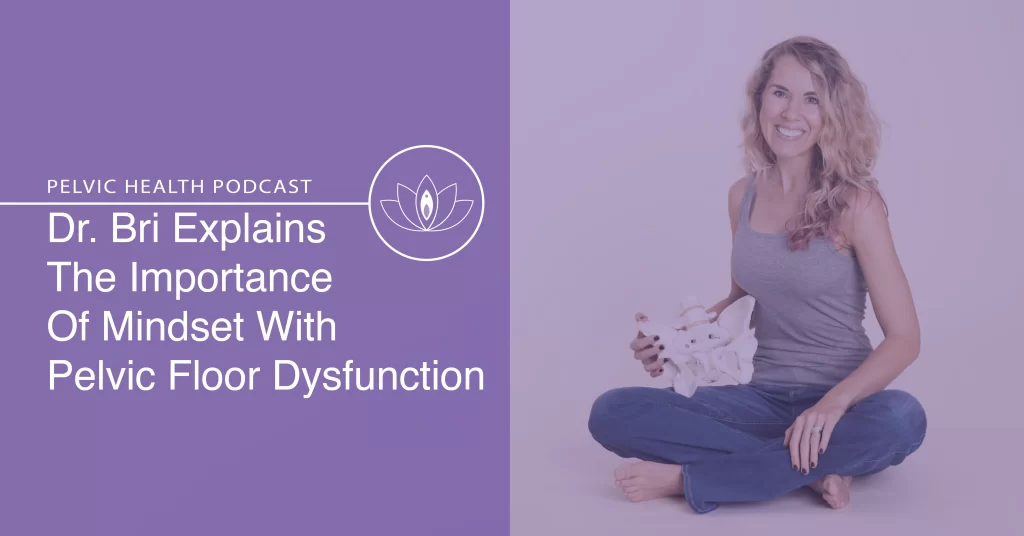Estimated reading time: 4 minutes
Earlier this year, I had the chance to speak with Dr. Branne Grogan of Femfusion Fitness (now Vibrant Pelvic Health) about the importance of mindset when dealing with pelvic floor dysfunction. She explained how the only way to really make change is to get the body to feel safe. Whether it’s riding the wave with overactive bladder or trying to calm down pain signals, finding ways to release tension and relax is the key to overcoming pelvic floor dysfunction.
For those of you who don’t already know Dr. Bri, she is a Doctor of Physical Therapy who has been inspiring both women and men to improve their pelvic health through her YouTube channel, her book, her podcast and her video courses (Lift for Prolapse, Overcome for Women and Overcome for Men). Dr. Bri’s YouTube channel has 600+ videos and over 200K subscribers. She posts weekly exercises videos and has an amazing pelvic health podcast with 80+ episodes.
Podcast with Dr Bri on YouTube
I’m delighted to share our video podcast today on YouTube. In the 30 minute podcast, we discuss conditions that are impacted by both pelvic floor hypertonicity and hypotonicity. She explains how she originally started making videos focused on general fitness before realising that many people needed more specific exercises focused on pelvic floor dysfunction.
She has curated her content on YouTube to cover both pelvic floor hypertonicity and hypertonicity but emphasises the importance of having an assessment from a pelvic floor physical therapist and following their guidance rather than just jumping in with YouTube. If you need a pelvic floor physical therapist, you can find one in our specialist directory.
The Importance of Taking Your Time
One of the key questions she gets is where to start and in what order to do videos. This is a question I also get frequently on my channel. It can be really difficult to make suggestions as what you should do is very much dependent on you and your specific body. The benefit of doing courses versus solely following YouTube videos is that they begin with assessments to measure where you are. They also offer a set schedule and have explainer videos with advice on each exercise, and shorter videos that you follow when doing the exercise. This helps to ensure time efficiency.
Another benefit of doing a course is that your assessments can be repeated to help you to decide whether or not you should move forward. Dr Bri explains how not seeing progress is generally an indication that you need to back off a bit rather than pushing forward. Lack of progress at a given level of training is usually an indication that your body is not ready to move forward with more difficult exercises. My own training program also follows this principle ensuring that you have the opportunity to progress, remain at a given level or regress depending on your own specific body. This ensures that you can take your time when working to overcome your pelvic floor dysfunction as change in the pelvic floor (and in the body and mind) happens slowly over time with repetition.
Dr. Bri’s Courses and Book
We are delighted to offer special discount on all of Dr Bri’s courses. Just contact us for the code and sign up using the affiliate links below:
Lift Pelvic Organ Prolapse Relief Program
This program helps those with pelvic organ prolapse to manage and improve their symptoms. It’s a five week program that you do from home and has already been completed by over 7000 people! Click this link to access the LIFT program.
Lift Pelvic Organ Prolapse Relief Program
This program helps those with pelvic pain to manage and improve their symptoms. It’s a twelve week program that you do from home and is available for men or women! Click this link to access OVERCOME for Women or Click this link to access OVERCOME for Men.
Watch my podcasts on Dr Bri’s channel from here:
Part 1: Pros and Cons of Pelvic Organ Prolapse Surgery and What to Try First.
Part 2: Pelvic Pain and Tension: What to know and How to Help.

